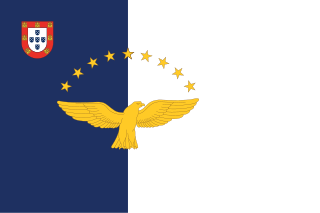
The Azores, officially the Autonomous Region of the Azores, is one of the two autonomous regions of Portugal. It is an archipelago composed of nine volcanic islands in the Macaronesia region of the North Atlantic Ocean, about 1,400 km (870 mi) west of Lisbon, about 1,500 km (930 mi) northwest of Morocco, and about 1,930 km (1,200 mi) southeast of Newfoundland, Canada.

Tradescantia is a genus of 85 species of herbaceous perennial wildflowers in the family Commelinaceae, native to the Americas from southern Canada to northern Argentina, including the West Indies. Members of the genus are known by many common names, including inchplant, spiderwort, and dayflower. The common name wandering Jew is controversial, and some vendors and bloggers have chosen to refer to it as wandering dude.

Aichryson is a genus of about 15 species of succulent, subtropical plants, mostly native to the Canary Islands, with a few in the Azores, Madeira and Morocco.

Remédios is a civil parish situated in along the northern coast of the municipality of Ponta Delgada in the Portuguese archipelago of the Azores. The population in 2011 was 931, in an area of 5.59 square kilometres (2.16 sq mi).

Santa Maria is an island in the eastern group of the Azores archipelago and the southernmost island in the Azores. The island is known for its white sand beaches, distinctive chimneys, and dry warm weather.
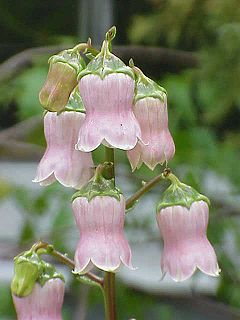
Azorina is a monotypic genus of flowering plants within the family Campanulaceae, whose sole species, Azorina vidalii, the Azores Bellflower, is endemic to the Azores. Its fragmented population is made up of fewer than 1000 mature plants limited to the coastlines of several of the islands. It is also the only species in this family native to the Azores.

Juniperus brevifolia, the Azores juniper, is a species of juniper, endemic to the Azores, where it occurs at altitudes of 240–800 m, rarely up to 1,500 m. It is closely related to Juniperus oxycedrus of the Mediterranean region and Juniperus cedrus of the neighboring Macaronesian islands. It is threatened by habitat loss.
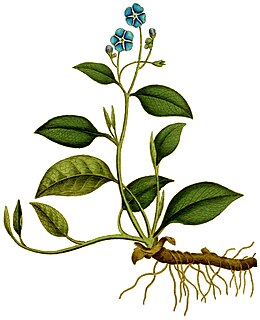
Omphalodes (navelwort) is a genus of flowering plants in the family Boraginaceae, widely distributed in the temperate Northern Hemisphere. In spring they produce blue or white flowers similar to forget-me-nots.

The Botanical Garden of Faial is an ecological garden, component of the Faial Nature Park, established in 1986 to educate and protect the biodiversity common on Faial, an island of the Azores archipelago.

Pico Alto is a mountain which is the highest point, 586.84 metres (1,925.3 ft), on the island of Santa Maria, in the Portuguese archipelago of the Azores.

Butia lallemantii is a species of palm described in 2006. Unlike more familiar Butia species, this is a clustering, acaulescent species lacking an above-ground trunk. It was the third of such species of Butia described. It is caespitose; branching underground with normally 3-6 branches. It grows to 60–160 cm tall, with 5-12 leaves with 24-40 leaflets a side. The fruit are edible, ovate-lanceolate, yellow-orange, 2.5-3.5 x 1.6-2.5 cm, with a reddish apex.
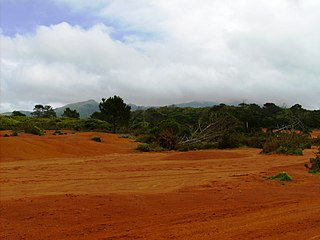
The Protected Landscape of Barreiro da Faneca is a geological region and protected landscape of the Portuguese island of Santa Maria, Azores. The protected area is given its name by the Barreiro da Faneca, nicknamed the "Red Desert of the Azores", an arid and clayey landscape formed during the Pliocene, unique not only to the island but to all of Portugal.
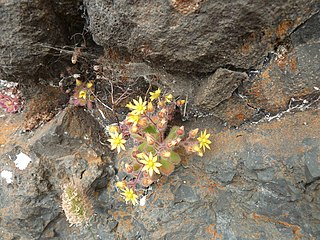
Aichryson villosum is a species of herbaceous flowering plants in the family Crassulaceae endemic to the Madeira Archipelago. The species was first described by Sabin Berthelot and Philip Barker-Webb in 1840, published in Natural History of the Canary Islands. Aichryson santamariensis was previously included in this species, but is now considered a different species endemic to Santa Maria Island, Azores.

The Azores temperate mixed forests is a temperate broadleaf and mixed forests ecoregion of southwestern Europe. It encompasses the Azores archipelago in the Atlantic Ocean. These volcanic islands are an autonomous region of Portugal, and lie 1500 km west of the Portuguese mainland.

Praia Islet is a highly vegetated uninhabited islet located approximately 1.5 kilometres away from the town of Praia off the eastern coast of the island of Graciosa in the Portuguese archipelago of the Azores. Along with Baixo Islet to its south, Praia Islet is one of two main breeding places of Monteiro's storm petrel, an endemic marine bird of the Azores.
Myrcia ascendens is a species of plant in the family Myrtaceae, endemic to Bahia in north-east Brazil, and first described in 2015.
Myrcia attenuata is a species of plant in the family Myrtaceae, endemic to French Guiana, and first described in 2015.
Myrcia rupestris is a species of plant in the family Myrtaceae, endemic to south-east Brazil, and first described in 2015.

Pericallis malvifolia is a species of flowering plant in the daisy family Asteraceae endemic to the Azores. It is found in coastal cliffs, ravines and interior of craters. In Santa Maria also on the side of roads and woods of Pittosporum undulatum. It appears from sea level to about 900 m (3,000 ft) altitude. It is present in Santa Maria, São Miguel, São Jorge, Pico and Faial.

Daviesia lancifolia is a species of flowering plant in the family Fabaceae and is endemic to the south-west of Western Australia. It is a prostrate to erect, spreading shrub with egg-shaped, more or less round or linear phyllodes and yellow to orange and red flowers.
















